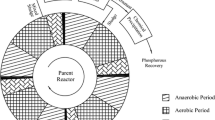Abstract
High-rate biological conversion of sulfide and nitrate in synthetic wastewater to, respectively, elemental sulfur (S0) and nitrogen-containing gas (such as N2) was achieved in an expanded granular sludge bed (EGSB) reactor. A novel strategy was adopted to first cultivate mature granules using anaerobic sludge as seed sludge in sulfate-laden medium. The cultivated granules were then incubated in sulfide-laden medium to acclimate autotrophic denitrifiers. The incubated granules converted sulfide, nitrate, and acetate simultaneously in the same EGSB reactor to S0, N-containing gases and CO2 at loading rates of 3.0 kg S m−3 d−1, 1.45 kg N m−3 d−1, and 2.77 kg Ac m−1 d−1, respectively, and was not inhibited by sulfide concentrations up to 800 mg l−1. Effects of the C/N ratio on granule performance were identified. The granules cultivated in the sulfide-laden medium have Pseudomonas spp. and Azoarcus sp. presenting the heterotrophs and autotrophs that co-work in the high-rate EGSB-SDD (simultaneous desulfurization and denitrification) reactor.




Similar content being viewed by others
References
Altschul SF, Madden TL, Schaffer AA, Zhang JH, Zhang Z, Miller W, Lipman DJ (1997) Gapped BLAST and PSI-BLAST: a new generation of protein database search programs. Nucleic Acids Res 25:3389–3402
Bassam BJ, Caetano-Anolles G, Gresshoff PM (1991) Fast and sensitive silver staining of DNA in polyacrylamide gels. Anal Biochem 196:80–83
Cadena F, Peters RW (1988) Evaluation of chemical oxidizer for hydrogen sulfide control. J Water Pollut Control Fed 60:1259–1263
Cardoso RB, Sierra-Alvarez R, Rowlette P, Flores ER, Gomez J, Field JA (2006) Sulfide oxidation under chemolithoautotrophic denitrifying conditions. Biotechnol Bioeng 95:1148–1157
Flere JM, Zhang TC (1999) Nitrate removal with sulfur-limestone autotrophic denitrification process. J Environ Eng, 125:721–729
Furumai H, Tagui H, Fujita K (1996) Effects of pH and alkalinity on sulfur-denitrification in a biological granular filter. Water Sci Technol 34:355–362
Inagaki F, Takai K, Nealson KH, Horikoshi K (2004) Sulfurovum lithotrophicum gen. nov., sp nov., a novel sulfur-oxidizing chemolithoautotroph within the epsilon-Proteobacteria isolated from Okinawa Torugh hydrothermal sediments. Int J Syst Evol Mic 54:1477–1482
Kim EW, Bae JH (2000) Alkalinity requirements and the possibility of simultaneous heterotrophic denitrification during sulfur utilizing autotrophic denitrification. Water Sci Technol 42:233–238
Kim SY, Jung HJ, Kim KS, Kim IS (2004) Treatment of high nitrate-containing wastewaters by sequential heterotrophic and autotrophic denitrification. J Environ Eng 130:1475–1480
Maidak BL, Cole JR, Parker CT, Garrity GM, Larsen N, Li B, Lilburn TG, McCaughey MJ, Olsen GJ, Overbeek R, Pramanik S, Schmidt TM, Tiedje JM, Woese CR (1999) A new version of the RDP (Ribosomal Database Project). Nucleic Acids Res 27:171–173
Manconi I, Carucci A, Lens P, Rossetti S (2006) Simultaneous biological of sulphide and nitrate by autotrophic denitrification in an acticated sludge system. Water Sci Technol 53:91–99
Oh SE, Yoo YB, Young JC, Kim IS (2001) Effect of organics on sulfur-utilizing autotrophic denitrification under mixotrophic conditions. J Biotechnol 92:1–8
Reyes-Avila J, Razo-Flores E, Gomez J (2004) Simultaneous biological removal of nitrogen, carbon and sulfur by denitrification. Water Res 38:3313–3321
Rozanova EP, Nazina TN, Galushko AS (1988) Isolation of a new genus of sulfate-reducing bacteria and description of a new species of this genus, Desulfomicrobium apsheronum gen. nov., sp. nov. Mikrobiologiya 57:634–641
Schwieger F, Tebbe CC (1998) A new approach to utilize PCR-single-strand conformation polymorphism for 16S rRNA gene-based microbial community analysis. Appl Environ Microbiol 64:4870–4876
Show KY, Tay JH, Yang LM, Wang Y, Lua CH (2004) Effects of stressed loading on startup and granulation in upflow anaerobic sludge blanket reactors. J Environ Eng 130:743–750
Vaiopoulou E, Melidis P, Aivasidis A (2005) Sulfide removal in wastewater from petrochemical industries by autotrophic denitrification. Water Res 39:4101–4109
Wang AJ, Du DZ, Ren NQ, van Groenestijn JW (2005) An innovative process of simultaneous desulfurization and denitrification by Thiobacillus denitrification. J Environ Sci Hlth A 40:1939–1949
Acknowledgement
This work was supported by National Nature Science Foundation of China (No. 50638020) and Ministry of Education of China (Development of Simutaneous desulfurization and denitrification process and the control strategy for high strength wastewater, New Century Distinguished young Scientist Supporting Plan).
Author information
Authors and Affiliations
Corresponding author
Rights and permissions
About this article
Cite this article
Chen, C., Ren, N., Wang, A. et al. Simultaneous biological removal of sulfur, nitrogen and carbon using EGSB reactor. Appl Microbiol Biotechnol 78, 1057–1063 (2008). https://doi.org/10.1007/s00253-008-1396-3
Received:
Revised:
Accepted:
Published:
Issue Date:
DOI: https://doi.org/10.1007/s00253-008-1396-3




